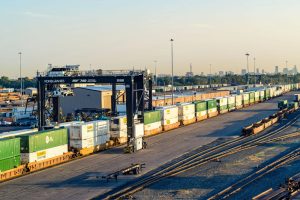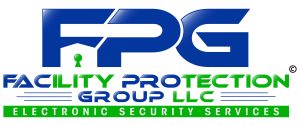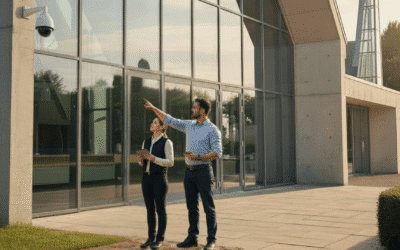 In an era where the transportation sector is pivotal to global commerce and daily commuting, ensuring the safety and efficiency of transportation facilities has never been more critical. With the increasing complexity of security threats, including terrorism, theft, and vandalism, the implementation of advanced physical security systems has become essential. These systems not only protect assets and individuals but also enhance operational efficiency and compliance with regulatory standards. This article delves into the myriad benefits of physical security systems in transportation facilities, exploring their impact on safety, efficiency, and overall operational integrity.
In an era where the transportation sector is pivotal to global commerce and daily commuting, ensuring the safety and efficiency of transportation facilities has never been more critical. With the increasing complexity of security threats, including terrorism, theft, and vandalism, the implementation of advanced physical security systems has become essential. These systems not only protect assets and individuals but also enhance operational efficiency and compliance with regulatory standards. This article delves into the myriad benefits of physical security systems in transportation facilities, exploring their impact on safety, efficiency, and overall operational integrity.
The Importance of Security in Transportation Facilities
Transportation hubs, such as airports, train stations, and bus terminals, are bustling environments that require robust security measures. The sheer volume of people and goods passing through these facilities presents unique challenges. Security systems must address various scenarios, from minor incidents like slip hazards to major emergencies such as terrorist threats.
Key Security Challenges
-
- High Foot Traffic: With thousands of individuals traversing these spaces daily, maintaining order and safety is paramount.
- Diverse Threats: Facilities face a range of security risks, including theft, vandalism, and potential terrorist activities.
- Regulatory Compliance: Transportation facilities must adhere to stringent security regulations to ensure public safety and avoid legal repercussions.
Enhanced Passenger Safety
One of the primary benefits of physical security systems is the enhancement of passenger safety. By integrating advanced surveillance technologies, transportation facilities can monitor activities in real-time, deterring criminal behavior and ensuring a secure environment.
Real-Time Monitoring
-
- CCTV Systems: Closed-circuit television cameras provide continuous surveillance, allowing security personnel to monitor activities and respond swiftly to incidents.
- Incident Documentation: Recorded footage serves as crucial evidence for investigations, helping to resolve disputes and enhance accountability.
Emergency Response
-
- Rapid Alerts: Integrated systems can send immediate notifications to security teams during emergencies, facilitating quick responses.
- Public Communication: Mass notification systems can inform passengers of potential threats or emergencies, guiding them to safety.
Operational Efficiency
Physical security systems contribute significantly to the operational efficiency of transportation facilities. By streamlining processes and enhancing communication, these systems help minimize delays and improve overall service delivery.
Streamlined Operations
-
- Automated Processes: Security systems can automate routine tasks, such as access control and incident reporting, freeing up personnel for more critical responsibilities.
- Centralized Management: A unified platform allows for the management of various security functions from a single interface, improving coordination among teams.
Data-Driven Insights
-
- Analytics and Reporting: Advanced security systems provide valuable data on passenger flow, incident frequency, and operational bottlenecks, enabling informed decision-making.
- Predictive Maintenance: By analyzing system performance, facilities can anticipate maintenance needs, reducing downtime and enhancing reliability.
Cargo and Asset Protection
For transportation facilities involved in freight and logistics, safeguarding cargo is a top priority. Physical security systems play a vital role in protecting goods from theft and damage.
Surveillance Solutions
-
- Monitoring Shipping Yards: Video surveillance in shipping areas deters theft and provides a visual record of cargo movements.
- Access Control: Restricting access to sensitive areas ensures that only authorized personnel can handle valuable assets.
Transparency and Accountability
-
- Tracking Systems: Integrated tracking solutions provide real-time visibility into cargo status, enhancing trust among stakeholders.
- Incident Documentation: Recorded footage can be used to investigate discrepancies or disputes regarding cargo handling.
Regulatory Compliance
Transportation facilities must comply with various security regulations to ensure public safety and avoid penalties. Physical security systems facilitate adherence to these standards.
Meeting Security Standards
-
- Continuous Monitoring: Surveillance systems provide the necessary oversight to meet regulatory requirements for security.
- Documentation and Reporting: Automated reporting features help facilities maintain accurate records for audits and inspections.
Training and Preparedness
-
- Standardized Training: Security personnel can undergo consistent training on system usage and emergency protocols, ensuring preparedness for various scenarios.
- Drills and Simulations: Regular drills help familiarize staff with emergency procedures, enhancing overall response capabilities.
Integration of Advanced Technologies
The integration of advanced technologies into physical security systems enhances their effectiveness and adaptability. By leveraging innovations such as artificial intelligence and cloud computing, transportation facilities can improve their security posture.
AI and Machine Learning
-
- Threat Detection: AI-powered systems can analyze video feeds to identify suspicious behavior or potential threats, enabling proactive responses.
- Facial Recognition: Biometric technologies enhance security by verifying identities and identifying individuals on watchlists.
Cloud-Based Solutions
-
- Remote Access: Cloud storage allows security personnel to access footage and data from anywhere, facilitating real-time monitoring and decision-making.
- Scalability: As facilities grow, cloud solutions enable easy integration of new devices and technologies without extensive infrastructure changes.
Enhancing Situational Awareness
Physical security systems improve situational awareness, allowing security personnel to respond effectively to incidents and maintain a safe environment.
Integrated Communication
-
- Mass Notification Systems: These systems enable rapid communication with staff and the public during emergencies, ensuring everyone is informed and can act accordingly.
- Real-Time Updates: Security teams can share live video feeds with emergency responders, enhancing coordination during critical situations.
Comprehensive Coverage
-
- Drones and Aerial Surveillance: Drones equipped with cameras provide aerial monitoring of large areas, detecting unauthorized access and monitoring traffic flow.
- Thermal Imaging: Thermal cameras enhance visibility in low-light conditions, ensuring comprehensive surveillance around the clock.
Cost-Effectiveness of Security Systems
Investing in physical security systems can lead to significant cost savings for transportation facilities. By preventing incidents and enhancing operational efficiency, these systems provide a strong return on investment.
Reducing Losses
-
- Theft Prevention: Visible surveillance acts as a deterrent to criminal activity, reducing losses from theft and vandalism.
- Minimizing Downtime: Proactive maintenance and incident response minimize disruptions, ensuring smooth operations.
Long-Term Savings
-
- Lower Insurance Premiums: Enhanced security measures can lead to reduced insurance costs, as facilities demonstrate a commitment to safety.
- Increased Efficiency: Streamlined operations and reduced incident response times contribute to overall cost savings.
Future Trends in Transportation Security
As technology continues to evolve, transportation facilities must adapt to emerging trends in physical security. Staying ahead of these developments is crucial for maintaining safety and efficiency.
Smart Security Solutions
-
- IoT Integration: The Internet of Things (IoT) enables the connection of various security devices, providing a comprehensive view of facility operations.
- Predictive Analytics: Advanced analytics can identify patterns and trends, allowing facilities to anticipate and mitigate potential security threats.
Enhanced Public Engagement
-
- Transparent Communication: Engaging the public in security measures fosters trust and cooperation, enhancing overall safety.
- Feedback Mechanisms: Facilities can implement systems for passengers to report concerns or incidents, improving situational awareness.
We Provide Physical Security for Transportation Facilities
Transportation companies need strong security solutions to guarantee passenger safety, safeguard valuable assets, and reduce potential security threats. With a wide range of assets such as vehicles, cargo, and infrastructure, transportation entities are vulnerable to theft, vandalism, and safety incidents. Implementing comprehensive security measures, including surveillance systems, access control, and trained security personnel, is essential to deter potential threats and provide a secure environment for passengers and employees.
> Learn More
The implementation of physical security systems in transportation facilities is essential for enhancing safety, efficiency, and compliance. By leveraging advanced technologies and integrating various security measures, these systems provide comprehensive protection for passengers, cargo, and assets. As the transportation sector continues to evolve, embracing innovative security solutions will be crucial for addressing emerging challenges and ensuring a secure environment for all.
Contact Us (877-762-6460) for a free consultation!
View Past Projects
—
 About Facility Protection Group
About Facility Protection Group
Facility Protection Group is a Certified Systems Integrator based in the Southeastern United States, specializing in electronic security services supporting both traditional and cloud based Access Control (Card Access), Video Surveillance / CCTV, Audio / Video Intercoms, and Intrusion Alarm Systems. Founded in 2018 and located in Tampa, Florida; Facility Protection Group has assembled a team that has a tremendous wealth of industry knowledge and experience.

 About Facility Protection Group
About Facility Protection Group

